Aboriginal Community Co-Design and Co-Build—Far More than a House
Abstract
:1. Introduction
Authors’ Note
- The authors have decided to use the first-person voice to allow for the narrative structure of the article and its presentation as a case study. It was considered that a depersonalised writing style would have made it difficult to adequately explain the process, particularly around the interpersonal, social, and cultural factors. Aboriginal culture is relationship oriented. Building interpersonal relationships will necessarily be at the core of any project that aims to work shoulder to shoulder with Aboriginal communities. The authors feel that understanding culture, building relationships, and incorporating community members at all stages is key in addressing the complexity of the challenges faced in Indigenous communities and that a more standard scientific language would detract from this concept and may encourage an unnecessarily prescriptive approach.
The Project
- Community co-design and co-build;
- Sustainable passive solar design suited to local climate;
- Use of earth (or other local, abundant material) as building material;
- Incorporation of education, community development, justice, and youth support.
2. Background and Setting: Bawoorrooga Community, East Kimberley
3. Methods
3.1. Community Co-Design Process
3.1.1. Available Materials and Labour
3.1.2. Design Stages and Modelling
3.2. Commencement with FISH: Foundation for Indigenous Sustainable Health
3.3. The Build Process
- The work was often physically taxing and done in extreme heat (up to 45 degrees Celsius).
- Throughout the entire duration of the project, the community lacked adequate accommodation—comprising only sheet-iron sheds and caravans. The abject poverty in which we and our workers resided was a major source of physical and psychological stress, reducing the workers’ capacity to engage. This also sat in the traumatic context of recently losing their home and belongings to fire.
- Claude and Andrea were responsible for feeding and housing the workers during the week, and often lacked money to purchase food or the means to make the 200 km round trip to the Fitzroy Crossing supermarket.
- In most of the Kimberley, physical and mental health issues are prevalent, commonly stemming from intergenerational trauma and the persistent legacy of colonisation. This hugely impedes normal, day-to-day functioning in these communities.
- Unemployment rates in the remote Kimberley are amongst the highest in Australia, with the majority of many communities being unemployed. Many members of our team had no prior working experience, and the project was their first introduction to daily routine, timetabling, and other norms common to workplaces.
4. Challenges
4.1. Resources and Funding
4.2. Climate and Remoteness
4.3. Cultural and Social
4.3.1. Time and Budgets
4.3.2. Trust and Exploitation
4.3.3. Gender
- Tasks and roles were typically assigned to genders. For example, women made most of the design decisions. Except for Jara and Andrea, men and boys did most of the building, and it was difficult to engage other women to participate in these tasks.
- People preferred direct communication with members of the same gender and generally avoided being alone with members of the opposite gender.
4.4. Mental and Physical Health
4.5. Land Tenure
4.6. COVID-19
5. Outcomes
5.1. Culturally Appropriate House
“That FISH mob—they’re the first people who ever really asked us what we wanted. They really sat down and designed it together with us. That design—it was the right one. It’s like they’ve lived with us for ten years!”
- The house contains (a) an outdoor and (b) an indoor kitchen area. The house, like many Kimberley houses, will be visited and used by a cast of thousands. Extended families are large, visits are frequent, the movement of people is fluid throughout the region. The indoor kitchen is intended exclusively for the occupants and is positioned to minimise foot traffic and enable Andrea to maintain a level of order and control over the space. The outdoor kitchen serves as the common area, accessible and usable by all comers. It contains a cooking firepit, a seating space, a storage space, and a washing area. The area is well shaded and shielded from the wind. Freshly hunted meat or fish is a common part of the Kimberley diet, the preparation of which is unavoidably messy. The area can be easily cleaned with a mop or hosed down.
- The house contains a bedroom which is not communicated with the other internal spaces of the house. The intention is that this space enjoys relative separation and independence—often important in the cultural relationship dynamics of the family.
- The house has an abundance of doors. Every space of the house provides two exits. This was important for the family to avoid feeling trapped. Particularly in the context of the trauma of the previous housefire, this was a relevant consideration.
- The toilet and bathroom are communicated only with the rear outside of the house—a preference relating to hygiene. The numerous visitors to the house are typically expected to use the separate ablution facilities located within close walking distance of the common area.
- Thick earthen walls provide excellent sound insulation [21]. This provides greater privacy and tranquility in the often lively tumult of community living.
- The walls and floors are made from earth ((a) the walls are lime rendered and (b) the floors are burnished and wax sealed), holding spiritual and symbolic importance. The outdoor floors are paved with flat river stones collected from traditional Gooniyandi hunting grounds (c). Claude talks about how the house contains the spirit of his ancestors, as well as a piece of every person who helped in the construction.
- The windows of the wet areas (bathroom and toilet) are circular. This shape represents the traditional symbol for the sacred “jilas” (waterholes) New visitors to the house are always taken to look at these windows when they are given the tour.
- Bawoorrooga is a community of artists, who love painting designs on their walls and tiles. The community also established a vibrant garden around the building, adding to the beauty of the place and providing modest additional cooling and shading.
5.2. Climatically Superior House
- Orientation and shape: The house mimics the shape of northern Australia’s magnetic termite mounds. They are long and thin, running east to west. When the sun is at its highest (and hottest), during summer and in the middle of the day, the roof provides complete shade. In early morning (east) and late afternoon (west), the sun is lower and so the roof provides less shade. Accordingly, the eastern and western sides of the house are narrow and do not contain openings, greatly reducing radiant heat absorption.
- Ventilated double roof: The house has a free-standing, white tropical roof with large eaves, shading the house like a giant umbrella, and a flat insulated roof underneath. This creates a simple double roof structure, allowing air to pass freely through the space between, dissipating the sun’s heat. It is far more efficient to stop heat from entering the house than having to remove heat from the inside.
- Air-movement: All rooms have opposite openings for cross-ventilation and a ceiling fan. This prevents the build-up of pockets of hot air and enables people’s bodies to naturally cool through the evaporation of sweat.
- Thermal mass: Thermal mass is the ability of a material to absorb, store, and release heat. High thermal mass materials, such as earth, have high thermal lag, meaning they change temperature very slowly. This is beneficial in climates where there is a reasonable temperature difference between day and night because it keeps temperatures closer to the average rather than rising and falling with the extremes. Meteorological data from nearby Halls Creek show that the temperatures can range between approximately 16 to 45 °C in January, and around 1 to 34 °C in July [23].
- Appropriate glazing: Double glazing or laminated windows reduce heat conduction through the glass and minimise radiant heat gain.
5.3. Lower Cost
- The principal building material is locally sourced earth which, aside from excavation costs, is free;
- Most of the workforce are volunteers, who directly benefit from the project through the use or ownership of the finished house or through participation in the various programs linked with the project (education, training, youth support, justice, etc.).
- Through the process of constructing the house, community members acquire many of the skills later required for routine maintenance, particularly if this is actively included as a training component of the build program. In Claude’s words: “We built it—we know how to fix it”.
- The importance of ownership and responsibility that comes with constructing one’s own house is impossible to overstate. Bawoorrooga Community members have a great psychological investment in the house. It is a source of pride and an expression of self, which generates far greater motivation to proactively maintain it.
- As discussed above, poorly performing houses, including houses with culturally inappropriate design, are often either abandoned or used in a way which accelerates their deterioration. Sensible design, adapted to climate and local living practices, means a house is more likely to be used as intended and, thus, endure for longer.
5.4. Community Pride
5.5. Education and Training
5.6. Justice
5.7. Broader Community Development
6. Core Principles
- Co-design: By genuinely enabling communities to design their dwellings, the results will be far more culturally appropriate and tailored to the needs of the people who will reside in them. As well as creating more functional houses, this factor is essential for residents’ sense of ownership. Incorporating community members at all stages is key in addressing the complexity of the challenges faced in these communities.
- Design suited to local climate: Passive solar design principles were used in this project. The Bawoorrooga house achieves its aim of passively mitigating climate extremes and providing consistent thermal comfort at low ongoing expense. Design solutions should always adapt to the place and local climate.
- Co-build: By heavily involving community members in the physical construction, the participants develop relevant skills and form a strong psychological investment in the house. As with co-design, this fosters pride and ownership and enables the community to take care of and maintain their house. It can also mitigate the project labour costs.
- Sustainable, local resources: Locally abundant resources, such as earth, are often more sustainable, cheaper, highly functional, and culturally preferred.
- Concurrent community initiatives: It is often possible to incorporate other essential community initiatives within the project framework, such as education, youth support and prison diversion programs, community governance, and enterprise development. Ideally, this would be done through longer-term partnerships, e.g., working with communities beyond the completion of a specific project. This allows progress to be consolidated and built upon, rather than the common scenario where support disappears suddenly, and isolated gains are quickly reversed.
7. Conclusions and Recommendations
Author Contributions
Funding
Institutional Review Board Statement
Informed Consent Statement
Acknowledgments
Conflicts of Interest
References
- Phibbs, P.; Thompson, S. The Health Impacts of Housing: Toward a Policy-Relevant Research Agenda; AHURI Final Report No. 173; Australian Housing and Urban Research Institute Limited: Victoria, Australia, 2011; p. 5. Available online: https://www.ahuri.edu.au/research/final-reports/173 (accessed on 14 January 2022).
- Quinterno, J.; Mary Reynolds Babcock Foundation. Helping People and Places Move Out of Poverty—Progress and Learning 2010; Briefing Paper. pp. 17, 22. Available online: https://www.mrbf.org/sites/default/files/midcoursereview.pdf (accessed on 13 January 2022).
- Kothari, M. United Nations Special Rapporteur on Adequate Housing; Mission to Australia; Preliminary Observations: Canberra, Australia, 2006. [Google Scholar]
- NITV. SBS Australia. Available online: https://www.sbs.com.au/nitv/the-point-with-stan-grant/article/2017/04/03/un-rapporteur-slams-governments-record-indigenous-issues-hopeful-change (accessed on 5 January 2022).
- Lea, T.; Grealy, L.; Moskos, M.; Brambilla, A.; King, S.; Habibis, D.; Benedict, R.; Phibbs, P.; Sun, C.; Torzillo, P. Sustainable Indigenous Housing in Regional and Remote Australia; AHURI Final Report No. 368; Australian Housing and Urban Research Institute Limited: Victoria, Australia, 2021; pp. 2–3. Available online: https://www.ahuri.edu.au/research/final-reports/368 (accessed on 5 January 2022).
- Ciancio, D.; Beckett, C. Rammed Earth: An Overview of a Sustainable Construction Material. In Proceedings of the Third International Conference on Sustainable Construction Materials and Technologies, Kyoto, Japan, 18–22 August 2013; pp. 1–2. [Google Scholar]
- Rusch, R.; Best, R. Sustainability: Its adaptation and relevance in remote area housing. Australas. J. Constr. Econ. Build. 2014, 14, 88. [Google Scholar] [CrossRef] [Green Version]
- United Nations Association of Australia WA Division. Available online: https://www.unaa-wa.org.au/post/united-nations-day-2019-gala (accessed on 13 January 2022).
- Banksia Foundation. Available online: https://banksiafdn.com/wp-content/uploads/2021/07/Ebook-2019_double-pages.pdf (accessed on 13 January 2022).
- Romero, J. SuperAdobe Self-Build Sustainable House. The Architect WA Homes Edition. 2020, pp. 86–88. Available online: https://www.architecture.com.au/wp-content/uploads/The-Arch_WA-Homes_AW2020_ONLINE-VERSION.pdf (accessed on 13 January 2022).
- Communities Containing Examples of These Natural Building Approaches Include: Aldeafeliz, San Francisco, Colombia; Proyecto Gaia, Santa Sofia Boyacá Colombia; Tierra Langla, Lunahuana, Peru; Baza Ulmu, Tautii Margheraus, Romania.
- Beckett, C.; Ciancio, D.; Hubner, C.; Cardell-Oliver, R. Sustainable and Affordable Rammed Earth Houses in Kalgoorlie, Western Australia: Development of Thermal Monitoring Techniques. In Proceedings of the Australasian Structural Engineering Conference, Aukland, NZ, USA, 9–11 July 2014; p. 1. [Google Scholar]
- Mudrooroo. Us Mob: History, Culture, Struggle: An Introduction to Indigenous Australia; Angus & Robertson: Sydney, Australia; New York, NY, USA, 1995; p. 34. [Google Scholar]
- Hunter, K.; Kiffmeyer, D. Earthbag Building: The Tools, Tricks, and Techniques; New Society Publishers: Gabriola Island, BC, Canada, 2004; Available online: https://archive.org/details/eb_Earthbag_Building-The_Tools_Tricks_and_Techniques (accessed on 24 February 2022).
- Kamal, R.; Rahman, S. A study on feasibility of super adobe technology—An energy efficient building system using natural resources in Bangladesh. IOP Conf. Ser. Earth Environ. Sci. 2018, 143, 012043. Available online: https://iopscience.iop.org/article/10.1088/1755-1315/143/1/012043/pdf (accessed on 24 February 2022). [CrossRef] [Green Version]
- Walker, P. The Australian Earth Building Handbook HB195; Standards Australia International: Sydney, Australia, 2002. [Google Scholar]
- Ware, V.-A. Housing Strategies that Improve Indigenous Health Outcomes; Resource Sheet No 25 Canberra: Closing the Gap Clearinghouse; Australian Institute of Health & Welfare: Darlinghurst, Australia, 2013. Available online: https://www.aihw.gov.au/getmedia/cfff298b-726d-477d-bf31-69f5052b6b04/ctgc-rs25.pdf.aspx?inline=true (accessed on 14 January 2022).
- McHugh, C.; Campbell, A.; Chapman, M.; Balaratnasingam, S. Increasing Indigenous Self-Harm and Suicide in the Kimberley: An Audit of the 2005–2014 Data. Med. J. Aust. 2016, 205, 33. [Google Scholar] [CrossRef] [PubMed]
- The Australian Indigenous Health. InfoNet, Overview of Aboriginal and Torres Strait Islander Health Status in Western Austalia. 2019. Available online: https://healthinfonet.ecu.edu.au/learn/health-facts/overview-aboriginal-torres-strait-islander-health-status (accessed on 5 January 2022).
- Haar, P. Chapter 17: A Self-help Approach to Remote Area Housing, St Paul’s Village, Moa Island, Torres Strait. 1986–1992. In Settlement: A History of Australian Indigenous Housing; Read, P., Ed.; Aboriginal Studies Press: Canberra, Australia, 2000; p. 233. [Google Scholar]
- Teslík, J.; Zdražilová, N.; Vodičková, M. Air-Tightness and Acoustic Properties of SuperAdobe System. Adv. Mater. Res. 2014, 899, 365–368. [Google Scholar] [CrossRef]
- Australian Government Department of Industry, Science, Energy and Resources. Your Home—Australia’s Guide to Environmentally Sustainable Homes, 6th ed.; p. 92. Available online: https://www.yourhome.gov.au/passive-design (accessed on 10 March 2022).
- Australian Government Bureau of Meteorology, Climate Data Online. Available online: http://www.bom.gov.au/climate/data/ (accessed on 24 February 2022).
- Rawlinsons. Rawlinsons Construction Cost Guide 2021; Rawlinsons Publishing: Perth, Australia, 2021. [Google Scholar]
- Habibis, D.; Phillips, R.; Spinney, A.; Phibbs, P.; Churchill, B. Reviewing Changes to Housing Management on Remote Indigenous Communities; AHURI Final Report No. 271; Australian Housing and Urban Research Institute: Victoria, Australia, 2016; p. 73. Available online: http://www.ahuri.edu.au/research/final-reports/271 (accessed on 5 January 2022). [CrossRef] [Green Version]
- Big Picture Learning Australia. Available online: https://www.bigpicture.org.au/ (accessed on 15 January 2022).
- Australian Institute of Health and Welfare. Aboriginal and Torres Strait Islander Health Performance Framework 2020 Summary Report; Australian Institute of Health and Welfare: Darlinghurst, Australia, 2020; p. 13.
- Government of Western Australia Department of Justice. Annual Report 2020–2021; Government of Western Australia Department of Justice: Perth, Australia, 2021; p. 26.
- Government of Western Australia Department of Justice. 2020 Statistics. Available online: https://www.correctiveservices.wa.gov.au/about-us/statistics-publications/statistics/default.aspx (accessed on 5 January 2022).
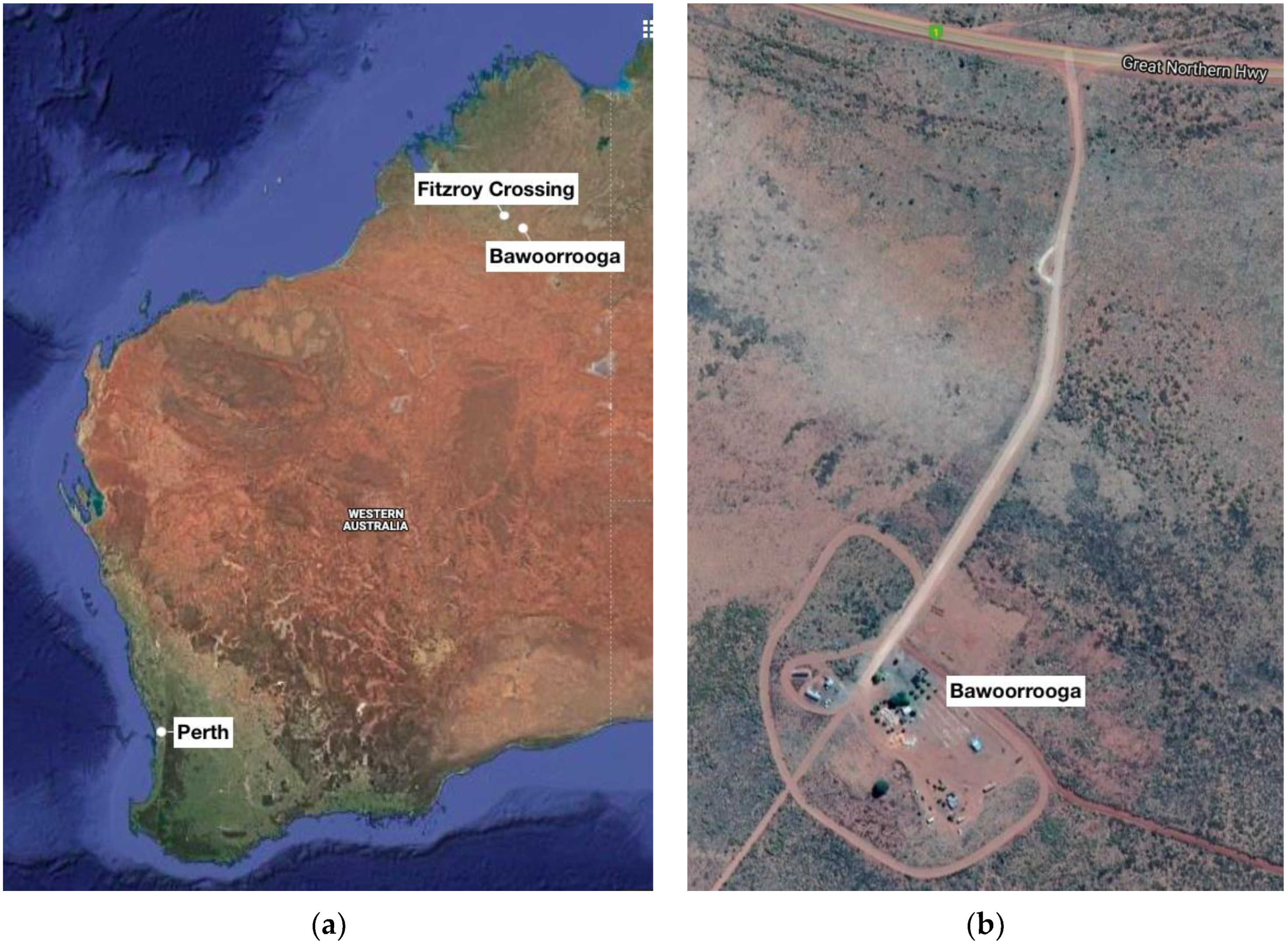
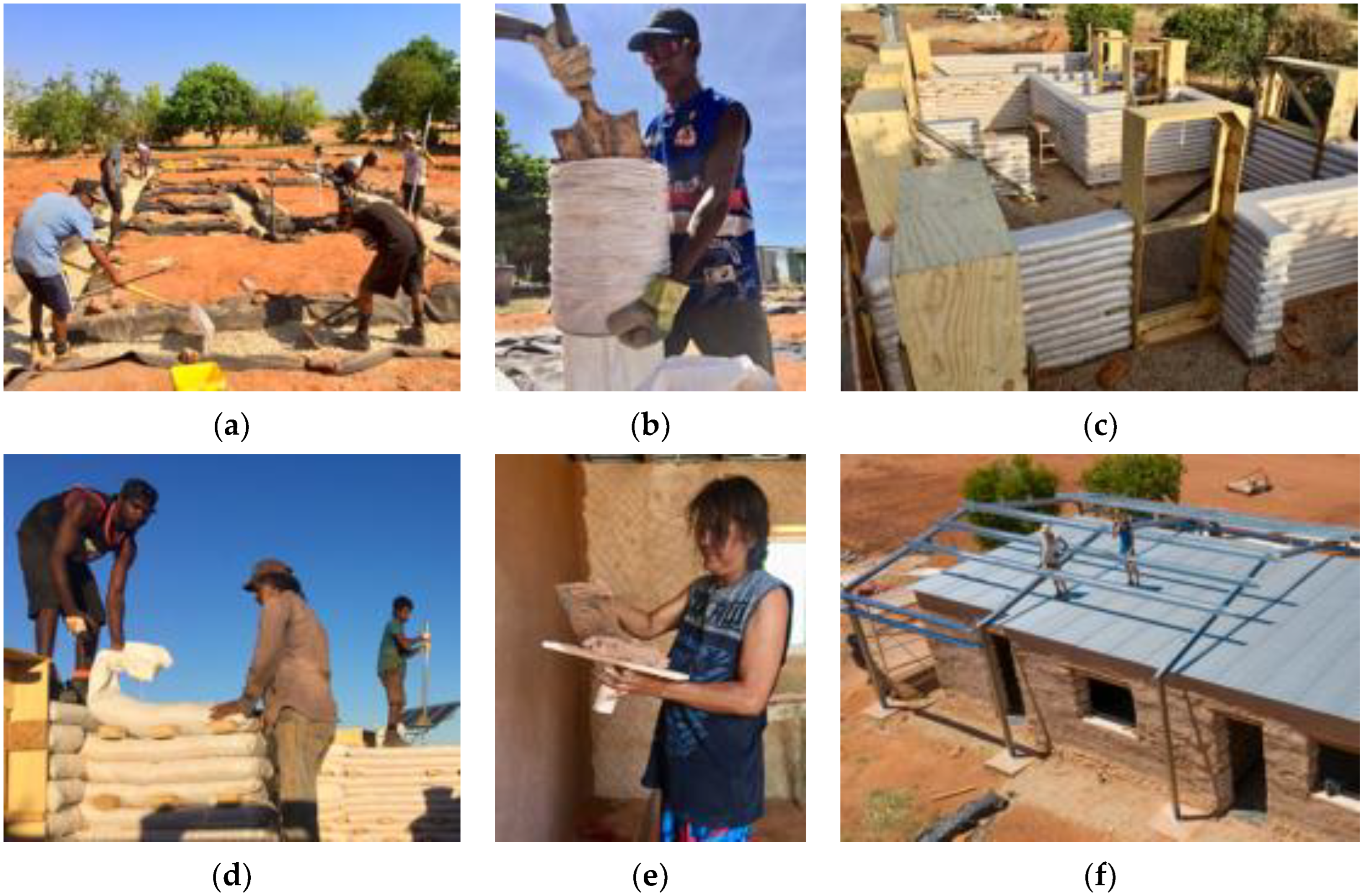
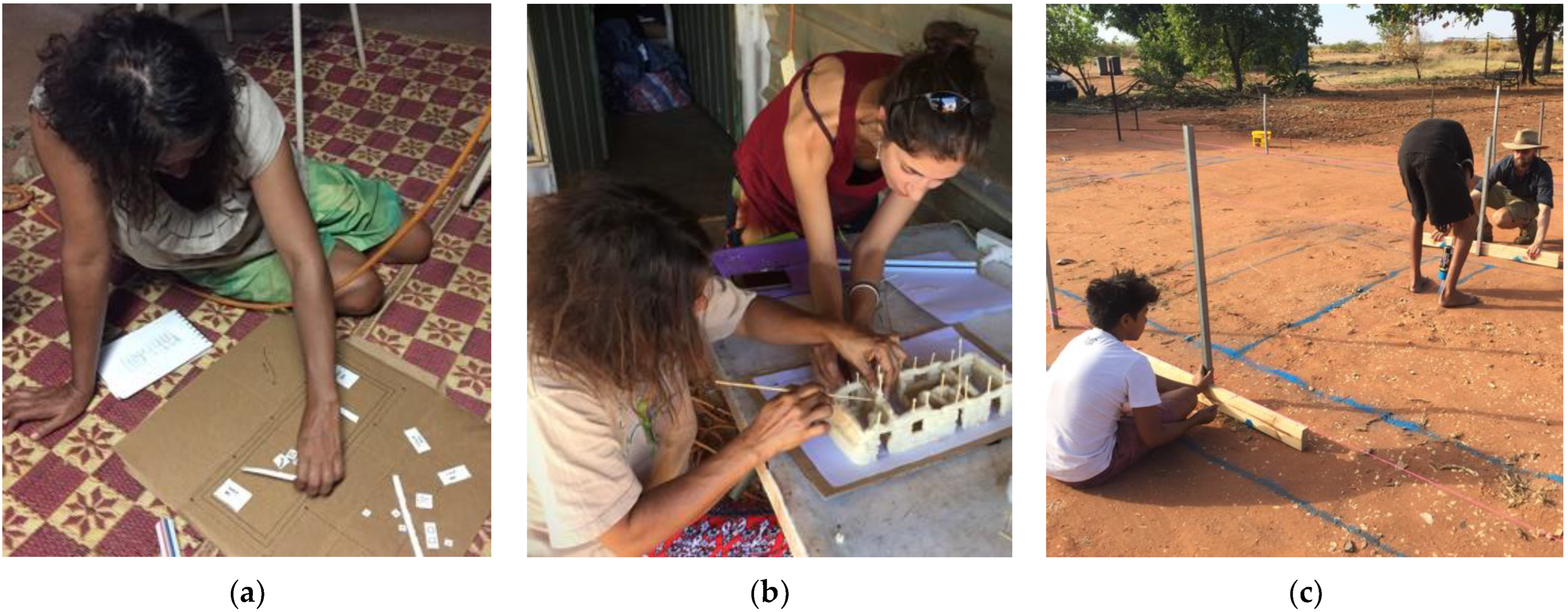
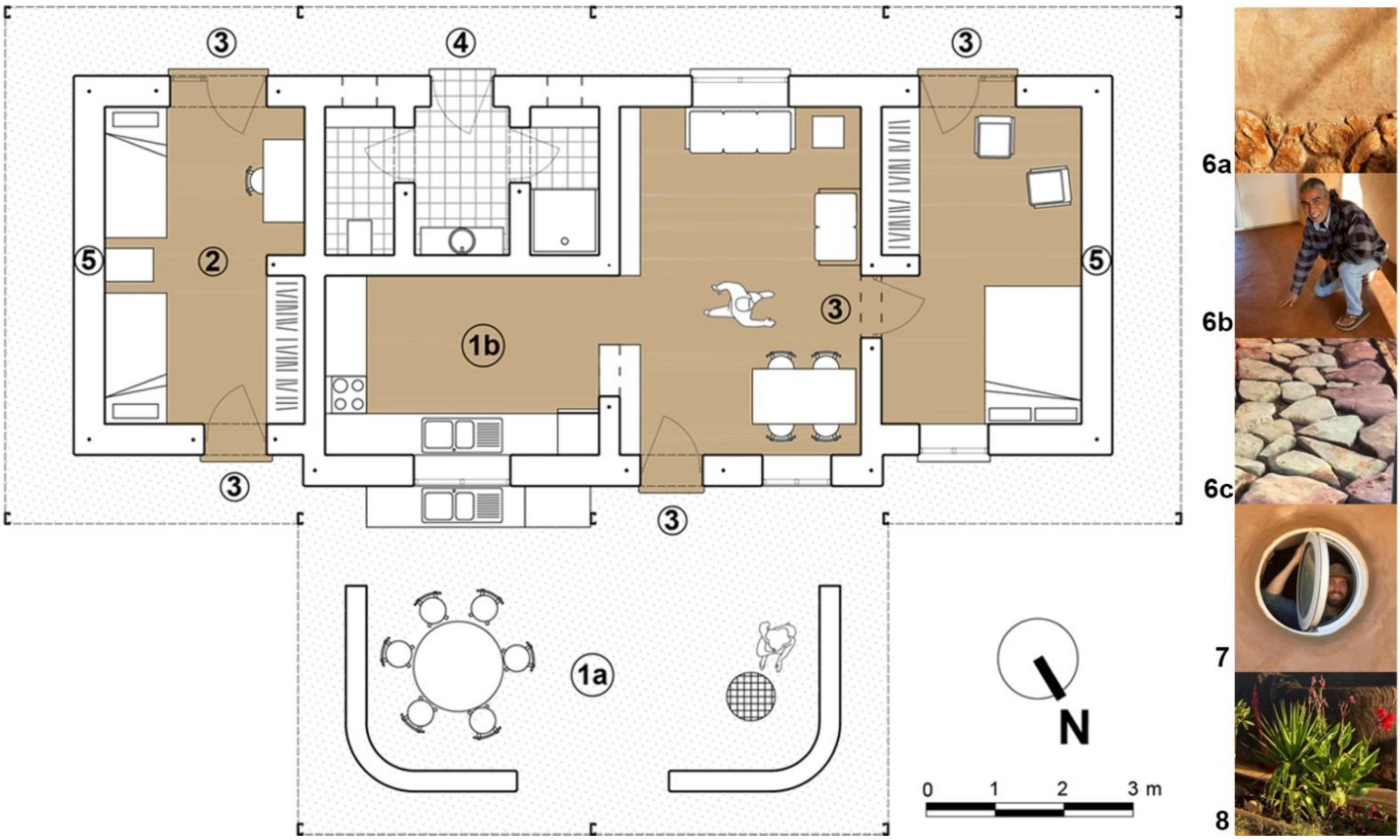
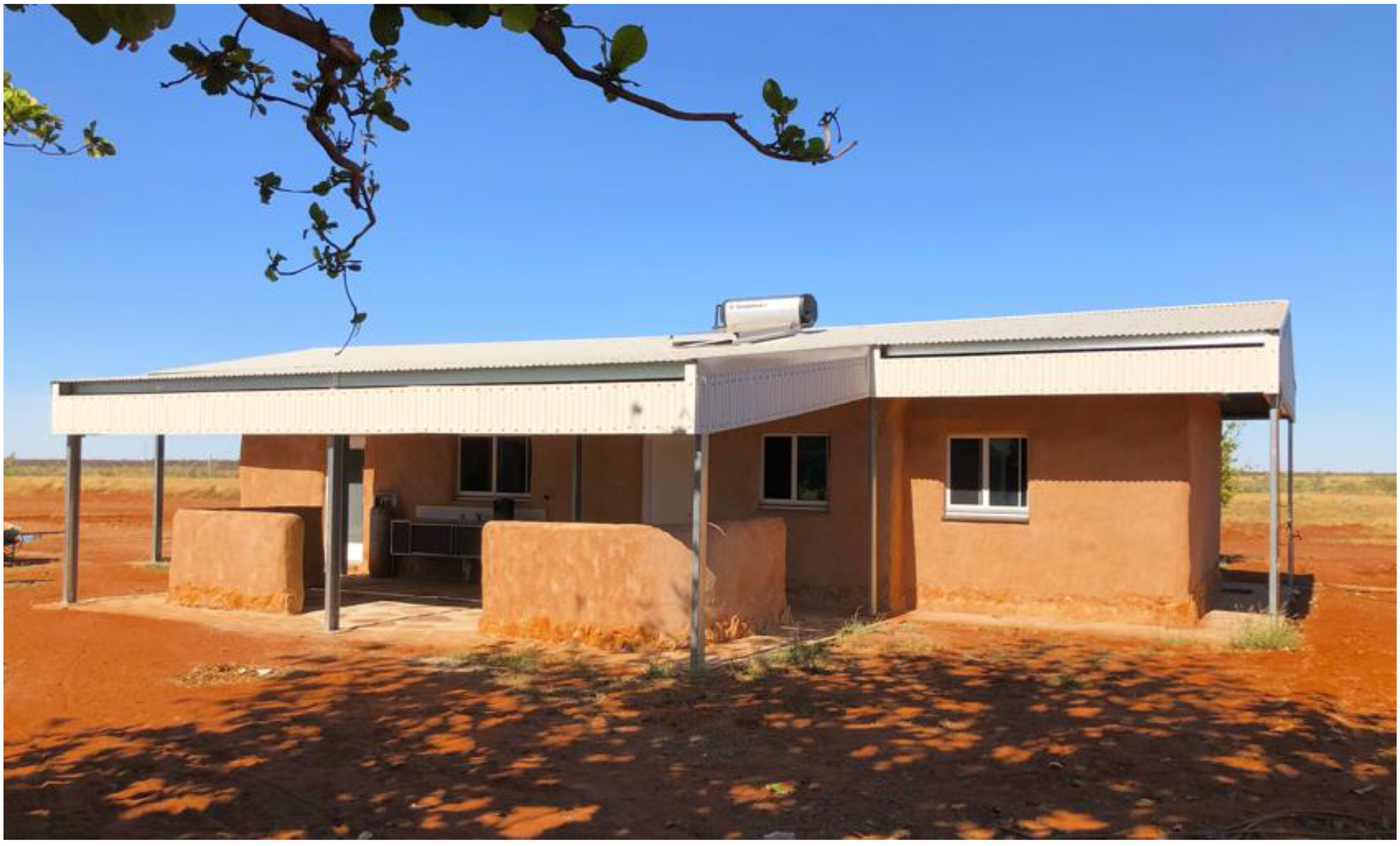
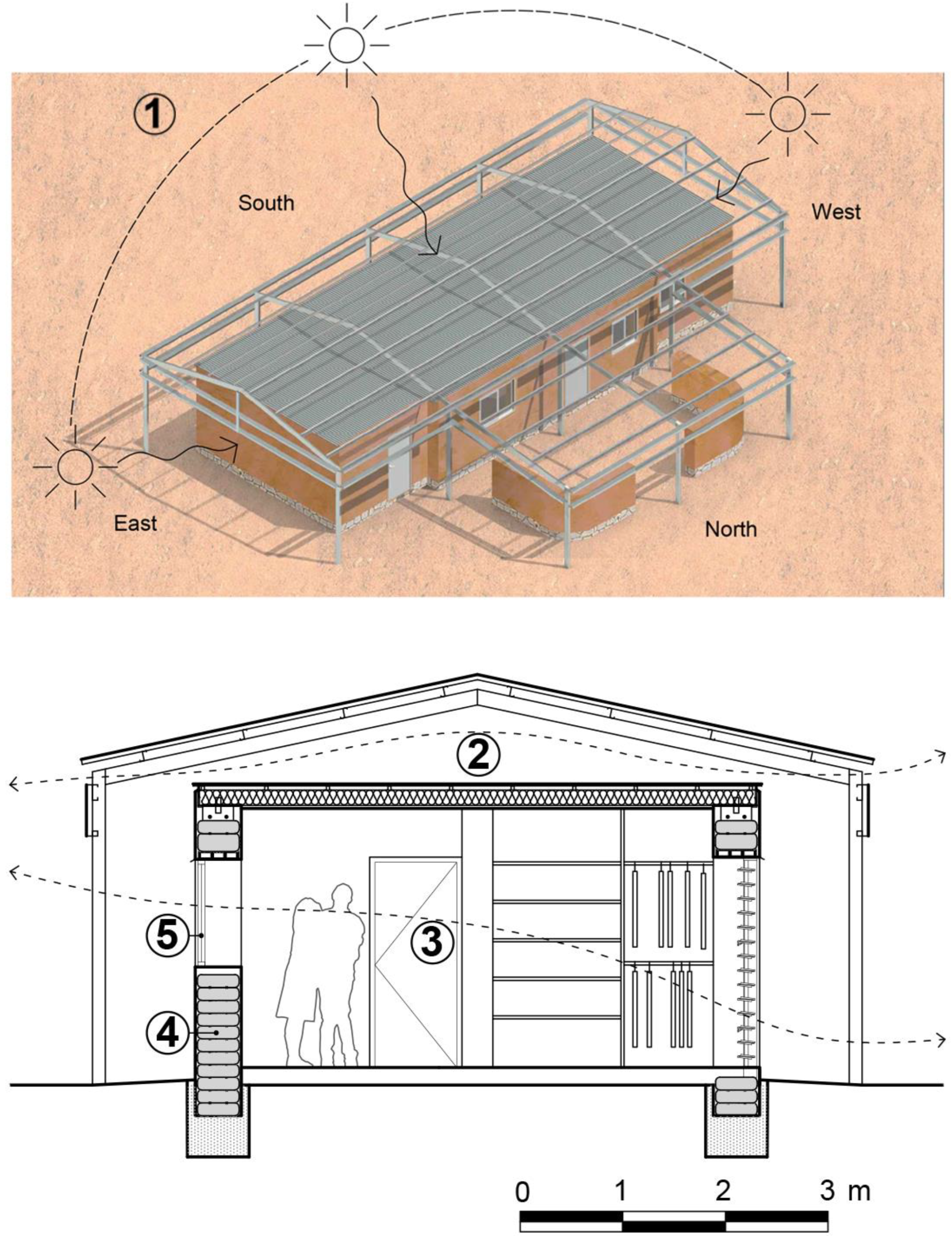

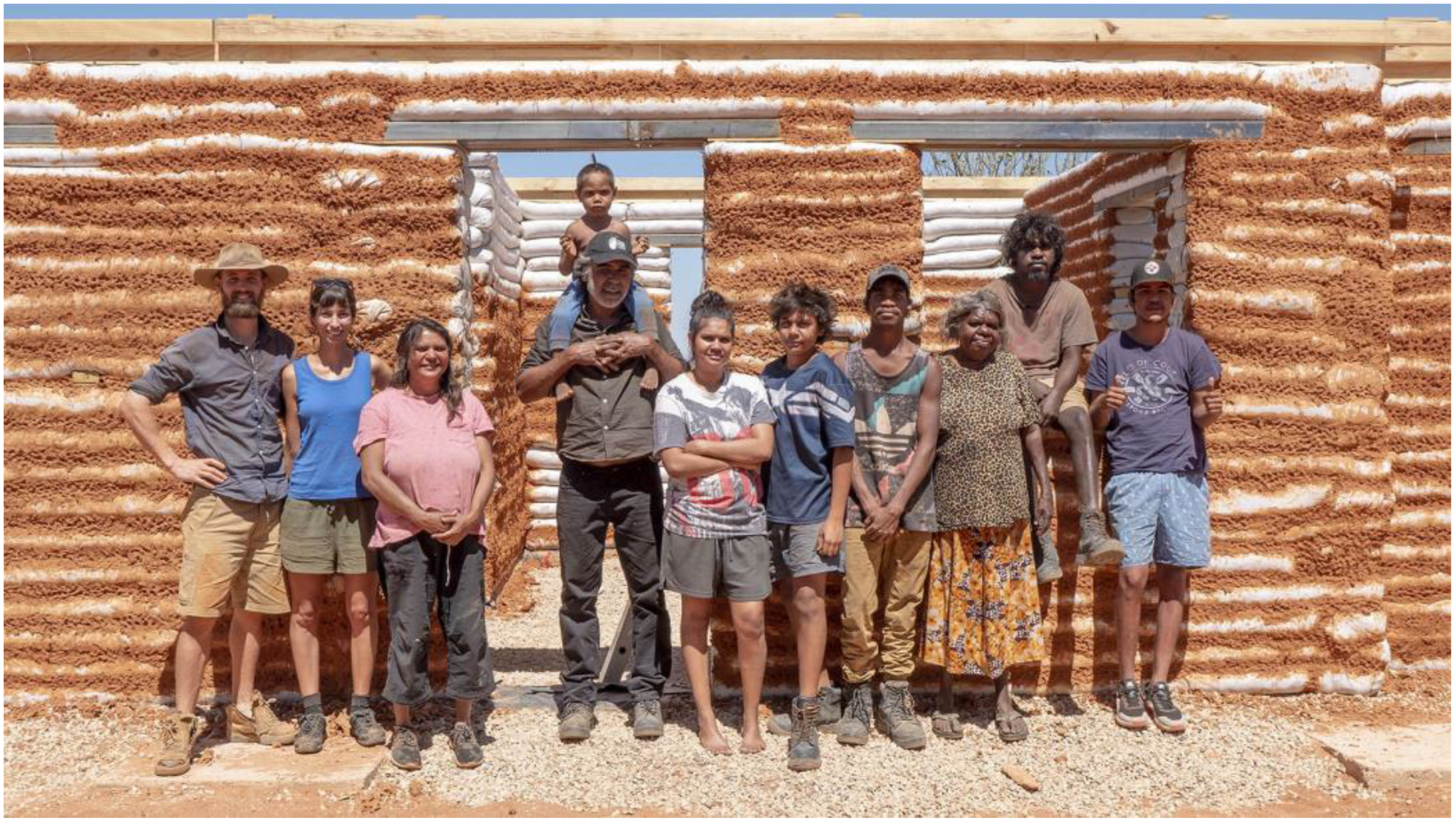
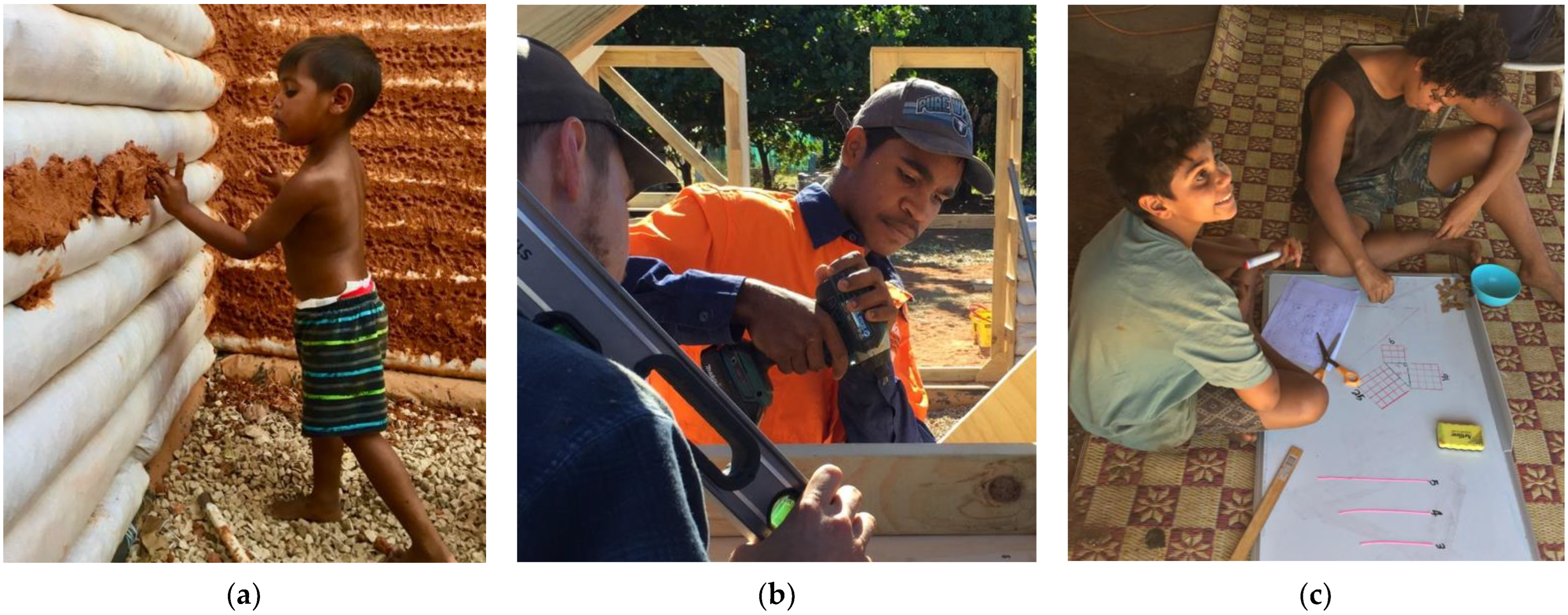
Publisher’s Note: MDPI stays neutral with regard to jurisdictional claims in published maps and institutional affiliations. |
© 2022 by the authors. Licensee MDPI, Basel, Switzerland. This article is an open access article distributed under the terms and conditions of the Creative Commons Attribution (CC BY) license (https://creativecommons.org/licenses/by/4.0/).
Share and Cite
Rodd, K.; Romero, J.; Hunter, V.; Martyn, S.V. Aboriginal Community Co-Design and Co-Build—Far More than a House. Sustainability 2022, 14, 5294. https://doi.org/10.3390/su14095294
Rodd K, Romero J, Hunter V, Martyn SV. Aboriginal Community Co-Design and Co-Build—Far More than a House. Sustainability. 2022; 14(9):5294. https://doi.org/10.3390/su14095294
Chicago/Turabian StyleRodd, Kristian, Jara Romero, Victor Hunter, and Scott Vladimir Martyn. 2022. "Aboriginal Community Co-Design and Co-Build—Far More than a House" Sustainability 14, no. 9: 5294. https://doi.org/10.3390/su14095294
APA StyleRodd, K., Romero, J., Hunter, V., & Martyn, S. V. (2022). Aboriginal Community Co-Design and Co-Build—Far More than a House. Sustainability, 14(9), 5294. https://doi.org/10.3390/su14095294




